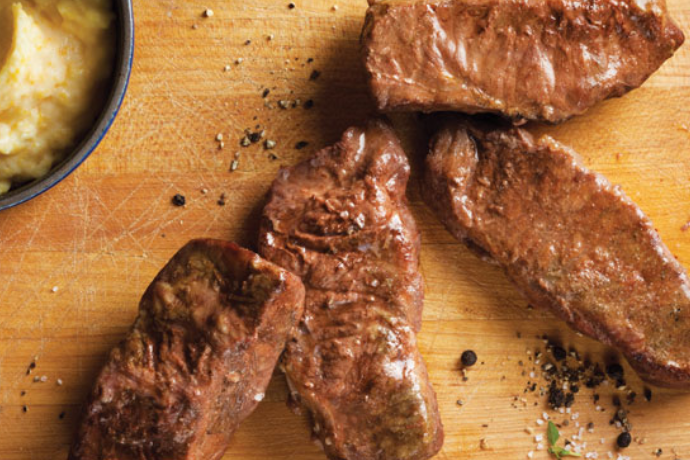Sous vide, a French term for “under vacuum,” is an innovative cooking technique mastered in the early 1970s. Food is vacuum sealed in a specially designed pouch, slow cooked in water at low temperatures until fully cooked and then flash frozen or refrigerated. High-end restaurants often use sous vide to cook food consistently to the exact level of doneness.
As the country faces the challenges brought on by COVID-19, chefs and foodservice operators may benefit from using sous vide prepared meat and poultry in their kitchens. In some instances, this may come in the form of purchasing product and garnishing and flavoring in house. In other cases, a culinary professional may work with a sous vide commercial manufacturer to prepare signature dishes for quick heating and plating. The fully cooked and pasteurized vacuum-sealed food eliminates unnecessary handling, assisting with food safety programs.
Sterling, Va.-based Cuisine Solutions assisted with menu development, as well as kitchen design for the upcoming Taffer’s Tavern franchise headquartered in Atlanta. The full-service casual restaurant concept is the brainchild of Jon Taffer, a hospitality consultant.
 Taffer recognized how sous vide technology could modernize and meet the needs of the new restaurant customer. He worked with Cuisine Solutions to develop a menu based on the technology.
Taffer recognized how sous vide technology could modernize and meet the needs of the new restaurant customer. He worked with Cuisine Solutions to develop a menu based on the technology.
“From the beginning, the vision for Taffer’s Tavern was to create a cutting-edge restaurant concept that combines food safety with a consistent, delicious, perfectly prepared menu. Safety is a key concern for our dining customers and that is what makes the Cuisine Solutions sous vide preparation so compelling,” Taffer said. “Everyone who eats at Taffer’s Tavern will not only be impressed by the taste and quality of the food coming out of the kitchen, but can feel secure the food will be safely prepared and not touched by the kitchen staff.”
A.J. Schaller, executive chef at Cuisine Solutions, worked with Taffer and his culinary team for several months to develop proprietary recipes that are exclusive to his new restaurant. Menu items include the Tavern Burger, which is an all-beef brisket blend patty cooked sous vide, that gets garnished with American cheese, iceberg lettuce, tomato, onion, mayonnaise and ketchup and served with herbed steak fries. The Tot Roast Fries are made with herbed tater tots topped with sous vide-prepared roast beef and gravy, along with cheese curds and a poached egg. The Roast Beef Au Jus is sous vide-braised sliced beef topped with caramelized onions, garlic butter and Swiss cheese all served on a toasted baguette and paired with au jus dip.
A key feature that differentiates Taffer’s Tavern is there is no hood or cooking vent in the kitchen. This translates to a smaller kitchen with less culinary staff to produce a diverse, quality menu with less labor costs for the back of the house.
Commercially produced sous vide meat and poultry may assist restaurants and institutions with getting back into business, according to Felipe Hasselmann, president and chief executive officer, Cuisine Solutions.
“The engineers, scientists and chefs at our sister company CREA (Culinary Research and Education Academy) all get involved with developing recipes,” Hasselmann said. “Any protein can be fully cooked and pasteurized using sous vide technology. It’s a healthier approach to preparing protein, as the product cooks in its own juices without the need for added fats.”
The experts will also work with meat and poultry companies to cook secondary cuts of meat that might go unused. This helps processors maximize the entire animal carcass, which results in more useable product and less waste. By manipulating the time and temperature of sous vide processing, it is possible to tenderize even some of the most challenging cuts.
“Sous vide enhances the flavors of all meats by cooking them in their own natural juices, and it can improve the quality of low-grade cut meats,” Hasselmann said. “The meat can be cooked in its own juice and distributed to foodservice operators for further preparation and garnishing. The precise, slow-cooking method of sous vide delivers a rich, flavorful finish.
“We sous vide slow cook short rib in its own juice – only with salt and pepper – for 72 hours,” Hasselmann said. “The result is an extraordinarily moist boneless beef dish with intense flavor and delicate texture. Chefs can add their own sauce for a signature dish.”
Product quality, consistency and shelf life are among the many benefits of sous vide. Frozen product has an 18-month shelf life, with seven days after thaw and three days after opening.
The sous vide method is also considered to be much safer than traditional on-site cooking methods. The process eliminates pathogens and microorganisms that may have been present in the raw state, which could cause spoilage. Doing this minimizes the chance for any type of contamination because the product is not further handled after cooking or exposed to the environment until opened by the end user.




